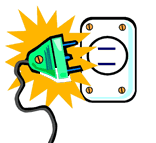Safety in practical lessons that use ELECTRICAL EQUIPMENT

-
 Only at A level will voltages above 12V be used with pupils. A full risk assessmnet for the HT supply must be completed before it is used for demonstrations. Only when Staff are fully aware of safe practice and the risk of electric shock can it be used in a classroom situation.
Only at A level will voltages above 12V be used with pupils. A full risk assessmnet for the HT supply must be completed before it is used for demonstrations. Only when Staff are fully aware of safe practice and the risk of electric shock can it be used in a classroom situation.
- Lab packs are PAT tested annually by the technical staff. If you are in doubt as to the safety of a lab pack DO NOT USE IT but remove it from the laboratory, clearly label the problem and leave it in the prep room for the technical staff to examine. Ensure that the girls carefully wind the flex and put the lab pack away on the trolley after use.
- Any snagged or loose connection connecting wires should be so marked and removed from the lab. Girls should be educated to insert and remove connecting wires from sockets holding the plugs. Tugging connections out by pulling the cables causes damage.
- The small black power supplies are not powerful enough to power the ray lamp bulbs. Too much current is drawn and they get very hot. Do not use them for this purpose. They were purchased for electronics use.
- Some of the rheostats are only designed to take 1A of current. Carefully look at the specifications stamped on the side before you use a rheostat and encourage the girls to be aware of the problem too.
- The Z-resistors should not be made to carry more than 1A otherwise they will get very hot (they have been known to glow if pupils are not taught to limit the current!) and could result in burns.
- Ray lamps are designed to be used at 12V (ac/dc). Encourage the girls to check the wiring carefully before they plug them in for any snags or tears and to hold/move the bulb by the wooden slider support rather than by the wires or metal cap.
- If a battery is short circuited it can get very hot, leak or even cause a fire. Always warn about short circuits and check the circuits that the girls wire up themselves very carefully.
- Fuse wire gets very hot! It can melt plastic (such as rulers are made of!) and heat proof mats must be used when it is melted, as must goggles.
Extracted from WGHS Physiscs Department hHandbook written by L.O. Jones 2005


